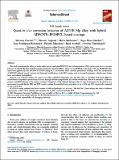Por favor, use este identificador para citar o enlazar a este item:
http://hdl.handle.net/10261/295971COMPARTIR / EXPORTAR:
 SHARE SHARE
 CORE
BASE CORE
BASE
|
|
| Visualizar otros formatos: MARC | Dublin Core | RDF | ORE | MODS | METS | DIDL | DATACITE | |

| Título: | Quasi-in vivo corrosion behavior of AZ31B Mg alloy with hybrid MWCNTs-PEO/PCL based coatings |
Autor: | Daavari, Morteza; Atapour, Masoud; Mohedano, Marta; Mora Sánchez, Hugo; Rodríguez-Hernández, Juan CSIC ORCID; Matykina, Endzhe; Arrabal, Raúl; Taherizadeh, Aboozar | Palabras clave: | AZ31B Mg alloy Plasma electrolyte oxidation (PEO) Multi-walled carbon nanotubes (MWCNTs) Quasi-in vivo condition Polycaprolactone (PCL). |
Fecha de publicación: | 2022 | Editor: | Elsevier | Citación: | Journal of Magnesium and Alloys 10: 3217- 3233 (2022) | Resumen: | This study investigated the effects of multi-walled carbon nanotubes (MWCNTs) and polycaprolactone (PCL) on the quasi-in vivo corrosion behavior of AZ31B Mg alloy treated by plasma electrolytic oxidation (PEO). Thin (∼2 µm, PCTPCL4) and thick (∼60 µm, PCTPCL6) PCL layers were applied only onto the MWCNTs-PEO coating (PCT) as it showed better corrosion performance. Findings reveal that incorporation of MWCNTs induced several structural and functional modifications in the PEO coating, such as increased roughness, a thicker inner barrier layer, and reduced hydrophilicity. Quasi-in vivo corrosion testing was carried out under controlled temperature, pH, and fluid flow in simulated body fluid (SBF) by electrochemical impedance spectroscopy (EIS) and hydrogen evolution experiments. EIS results revealed that, after 48 h immersion, a diffusion process controlled hydration of the ceramic coatings. Comparison of the collected hydrogen after 15 days of immersion in the quasi-in vivo environment revealed that the PEO and PCT ceramic coatings decreased hydrogen generation by up to 74% and 91%, respectively, compared to non-coated alloy. PCTPCL6 coating exhibited the lowest amount of collected hydrogen (0.2 mL/cm). The thick PCL layer delayed the onset of substrate corrosion for at least 120 h, reducing the corrosion rate by 85% compared with the PCT. | Versión del editor: | http://dx.doi.org/10.1016/j.jma.2021.09.010 | URI: | http://hdl.handle.net/10261/295971 | DOI: | 10.1016/j.jma.2021.09.010 | Identificadores: | doi: 10.1016/j.jma.2021.09.010 issn: 2213-9567 |
| Aparece en las colecciones: | (ICTP) Artículos |
Ficheros en este ítem:
| Fichero | Descripción | Tamaño | Formato | |
|---|---|---|---|---|
| 1-s2.0-S2213956721002462-main.pdf | 6,58 MB | Adobe PDF |  Visualizar/Abrir |
CORE Recommender
SCOPUSTM
Citations
22
checked on 03-may-2024
WEB OF SCIENCETM
Citations
14
checked on 29-feb-2024
Page view(s)
14
checked on 11-may-2024
Download(s)
34
checked on 11-may-2024
Google ScholarTM
Check
Altmetric
Altmetric
NOTA: Los ítems de Digital.CSIC están protegidos por copyright, con todos los derechos reservados, a menos que se indique lo contrario.
